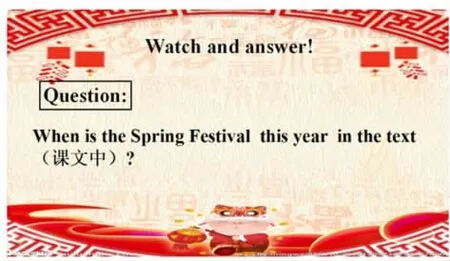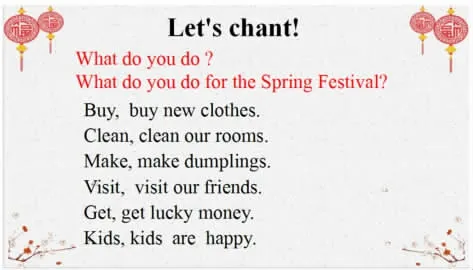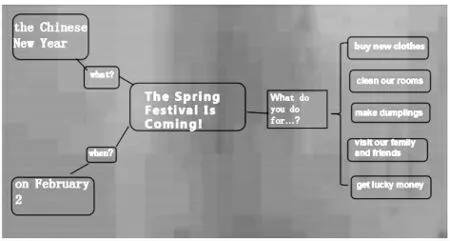冀教版《英语》(三起)五(上)Unit 4 Lesson 20 The Spring Festival is coming!
2022-11-20韩笑雨
文|韩笑雨
教学过程
Step 1.Warming-up and Leading-in
Listen and talk.
播放歌曲“Happy New Year”,师生一起欢唱。
T:What’s the date today?
S1:It’s Dec.26 today.
T:When is New Year’s Day?
S2:It’s on January 1.
T:New Year’s Day is coming.
继续播放另一段乐曲《春节序曲》,让学生欣赏。
T:How do you feel when you listen to the music?
S3:I feel very happy.
T:Yes.We feel happy and nice.What is it about?
Ss:春节!

设计意图:通过播放两段乐曲,让学生区分New Year’s Day(元旦)和the Spring Festival(春节),既营造了轻松愉快的课堂氛围,又顺势导入了文本的学习。
Step 2.Presentation and Practice
1.Learn and say
T:It’s Chinese New Year.We also call it the Spring Festival.Now can you answer me?What’s the Spring Festival?
Ss:The Spring Festival is Chinese New Year.
T:When is the Spring Festival?
S1:It’s in February.
T:Always?
S2:Sometimesit’sin January.
T:Yes.The Spring Festival is usually in January or February.When is the Spring Festival this year?Let’s look at the calendar.
Ss:It’s on February 1st this year.
T:The Spring Festival is coming!Today we’ll learn Lesson 20 The Spring Festival is coming!

设计意图:发挥学生的自主能动性,根据生活实际和查阅日历思考并解答问题。通过师生、生生互动,在学生充分理解讨论话题的基础上,引入课文题目学习,揭示本课主题和重点。
2.Watch and answer
T:Li Ming,Jenny and Danny are talking about the Spring Festival.Watch and listen carefully.When is the Spring Festival this year in the text?Please find out the answer.

设计意图:正式进入文本学习,让学生带着问题观看课文视频,在寻读文中当年春节日期的同时,进行文本的整体输入,感知并熟悉全文对话内容。
3.Learn the key
(1)Read and underline
让学生自由阅读课文,画出所提问题的答案。
T:Read the text by yourselves.Underline the answer to this question.
Q:What do we do for the Spring Festival in the text?
(2)Listen and match
带领学生再次听读课文,完成图文搭配练习。
T:Please listen to the text again,then match.

设计意图:通过反复听、读课文,多次输入语言学习目标,借助画出问题答案和图文搭配两个阶梯式的学习活动,让学生理解、识记本课关于春节活动的英文短语,在此过程中突破本课难点。
4.Choose and say
T:There are some red lanterns.Choose one and say.What do you do for the Spring Festival?
选择一名学生,让其选择一个红灯笼,点击图片出现英文短语,借助提示回答春节期间会做的事情。

设计意图:将具有春节节日气氛的红灯笼设计成语言目标的巩固练习,以增强学习感染力和趣味性。在活动中通过反复操练,让学生熟练掌握本课重点语言目标。
5.Think and say
当谈到“We visit our family.”时,与学生进行深入交流,让学生感受随着互联网越来越发达,人与人之间的联络越来越便捷。
T:Who do you visit?How do you visit them?
S1:We visit my grandmother and grandfather.They live in another city.We take a train to their home.
T:Sometimes we can’t visit somebody,but there are some other ways to greeting.Please think and say.
S2:We can say Happy the Spring Festival to our teacher on the phone.
S3:We can write an e-mail to our friends.
T:You are clever.When we miss somebody,we want to see him or her.We can have a video chat.

设计意图:发散学生思维,培养学生的思维品质。让学生总结生活中除了登门拜访,还可以采用电话问候、发送邮件、视频聊天等其他方式联络。
6.Let’s chant

设计意图:通过带有节奏感的Chant问答,再次让学生巩固本课重点对话。
Step 3.Extension and Consolidation
1.Watch and talk
T:Please watch a video and learn more about the Spring Festival.Then let’s talk.What else do we do for the Spring Festival?

设计意图:让学生观看视频,学习更多课外的关于欢度春节的表述,如paste the couplets,watch the Spring Festival gala,have a big family dinner,do the dragon dance...丰富学生表达,积累语言知识。
2.Choose and do
为学生设计两个练习,表达形式分别为写和说。
(1)Make a mind-map of the Spring Festival
同桌合作,根据所学绘制一张关于春节的思维导图,梳理本课学习内容,总结要点。

(2)Introduce the Spring Festival
个人或小组合作,向来中国参加冬奥会的外国朋友介绍春节的有关习俗。

设计意图:关注学生个性特点,学生可以选择其中一个练习活动,不仅有写和说形式上的区分,还有个人和团体合作两种方式可供选择,可满足学生不同的个性需求,最大限度地发挥学生自主能动性,降低学生语言输出的难度。
Step 4.Summary(略)
Homework:Make a poster of the Spring Festival.
附:板书设计

